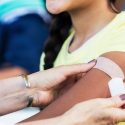Mumps
The 1967 introduction of the mumps vaccine was a game changer in the United States, dropping the annual number of cases from 200,000 to less than 1,000. The Centers for Disease Control (CDC) explains mumps as a contagious disease caused by a virus infecting many parts of the body, especially the parotid salivary glands. These glands, found toward the back of each cheek and between the ear and jaw, are responsible for producing saliva in your mouth.
Mumps can be transmitted through talking, sneezing, coughing, sharing of utensils, and touching infected objects.
Symptoms
Symptoms can appear between 12 and 25 days after infection. Everyone experiences mumps differently, and symptoms differ between individuals. Some symptoms to look for include fever of up to 103 ̊F; headache; loss of appetite; pain and swelling of one or both sides of the parotid glands; and pain and discomfort while swallowing, talking, chewing, or drinking.
Complications can be serious, including inflammation of the brain, testicles (in males who have reached puberty), and ovaries and breast tissue as well as the possibility of deafness.
Prevention
Preventing measles is as simple as timely vaccination with the MMR (measles, mumps, and rubella) vaccine, with the CDC recommending the following schedule:
- First vaccination at 12 to 15 months of age.
- Second vaccination at 4 to 6 years of age.
- Teens and adults should keep current on their vaccination.
Keep yourself and your family mumps-free through proactivity. Having a good relationship with a family doctor who knows about your medical and family history and lifestyle can be helpful with preventing diseases and reducing health risks.
Resources:
Mumps: www.cdc.gov/mumps/
Kids Health: http://kidshealth.org/en/parents/mumps.html




